2016 NISSAN LEAF child restraint
[x] Cancel search: child restraintPage 2 of 437

Welcome to the growing family of new NISSAN
owners. This vehicle is delivered to you with
confidence. It was produced using the latest
techniques and strict quality control.
This manual was prepared to help you under-
stand the operation and maintenance of your
vehicle so that you may enjoy many miles of
driving pleasure. Please read through this manual
before operating your vehicle.
A separate Warranty Information Booklet
explains details about the warranties cov-
ering your vehicle. The NISSAN Service and
Maintenance Guide explains details about
maintaining and servicing your vehicle. Ad-
ditionally, a separate Customer Care/
Lemon Law Booklet (U.S. only) will explain
how to resolve any concerns you may have
with your vehicle, as well as clarify your
rights under your state’s lemon law.In addition to factory installed options, your ve-
hicle may also be equipped with additional ac-
cessories installed by NISSAN or by a NISSAN
certified LEAF dealer prior to delivery. It is impor-
tant that you familiarize yourself with all disclo-
sures, warnings, cautions, and instructions con-
cerning proper use of such accessories prior to
operating the vehicle and/or accessory. See a
NISSAN certified LEAF dealer for details con-
cerning the particular accessories with which
your vehicle is equipped.
A NISSAN certified LEAF dealer knows your
vehicle best. When you require any service or
have any questions, we will be glad to assist you
with the extensive resources available to us.
Before driving your vehicle, read your Owner’s
Manual carefully. This will ensure familiarity with
controls and maintenance requirements, assist-
ing you in the safe operation of your vehicle.
WARNING
IMPORTANT SAFETY INFORMATION RE-
MINDERS!
Follow these important driving rules to
help ensure a safe and comfortable trip
for you and your passengers!
• NEVER drive under the influence of alcohol or drugs.
• ALWAYS observe posted speed limits and never drive too fast for conditions.
• ALWAYS give your full attention to driving and avoid using vehicle fea-
tures or taking other actions that could
distract you.
• ALWAYS use your seat belts and ap- propriate child restraint systems. Pre-
teen children should be seated in the
rear seat.
• ALWAYS provide information about the proper use of vehicle safety fea-
tures to all occupants of the vehicle.
• ALWAYS review this Owner’s Manual for important safety information.
FOREWORD READ FIRST — THEN DRIVE SAFELY
Page 9 of 437
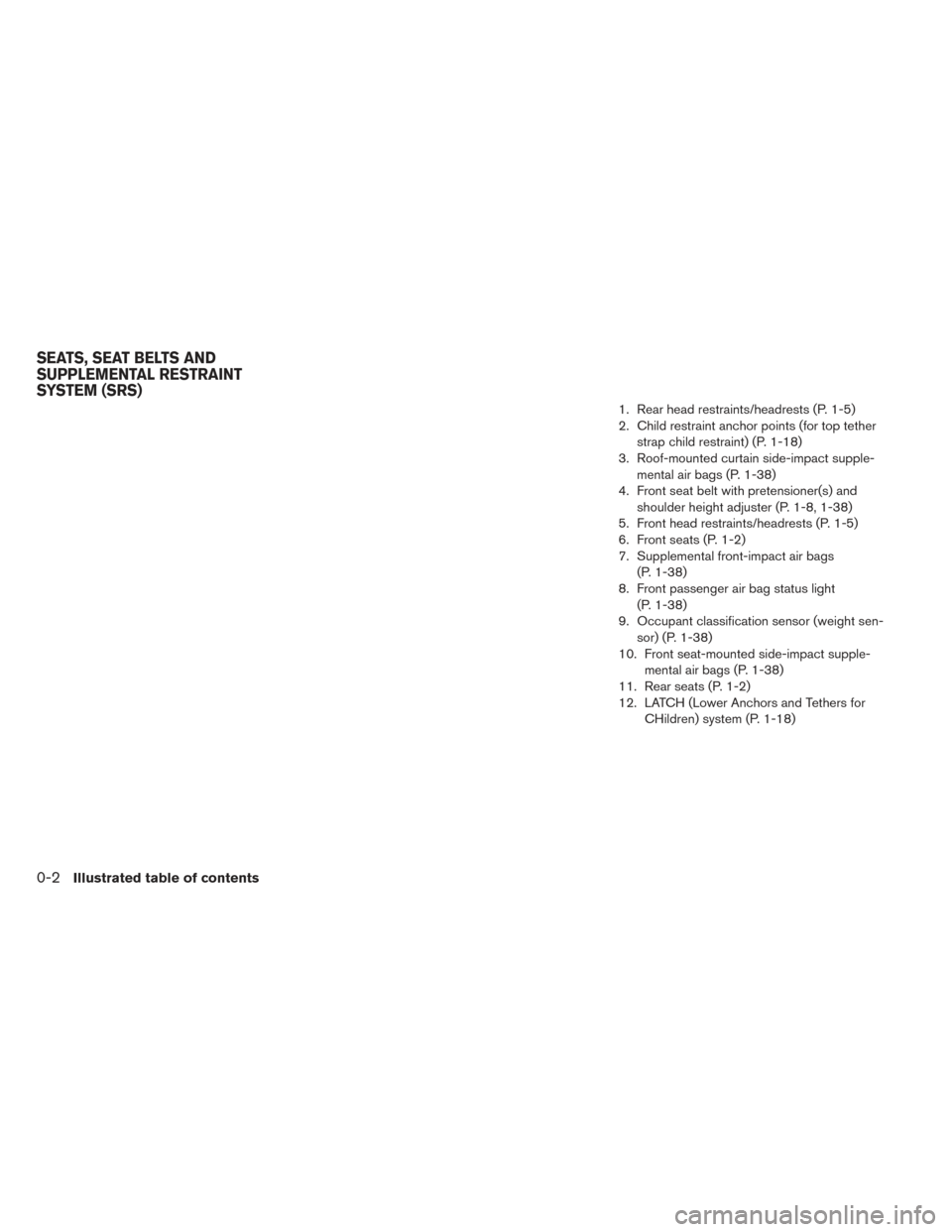
1. Rear head restraints/headrests (P. 1-5)
2. Child restraint anchor points (for top tetherstrap child restraint) (P. 1-18)
3. Roof-mounted curtain side-impact supple- mental air bags (P. 1-38)
4. Front seat belt with pretensioner(s) and shoulder height adjuster (P. 1-8, 1-38)
5. Front head restraints/headrests (P. 1-5)
6. Front seats (P. 1-2)
7. Supplemental front-impact air bags (P. 1-38)
8. Front passenger air bag status light (P. 1-38)
9. Occupant classification sensor (weight sen- sor) (P. 1-38)
10. Front seat-mounted side-impact supple- mental air bags (P. 1-38)
11. Rear seats (P. 1-2)
12. LATCH (Lower Anchors and Tethers for CHildren) system (P. 1-18)
SEATS, SEAT BELTS AND
SUPPLEMENTAL RESTRAINT
SYSTEM (SRS)
0-2Illustrated table of contents
Page 84 of 437
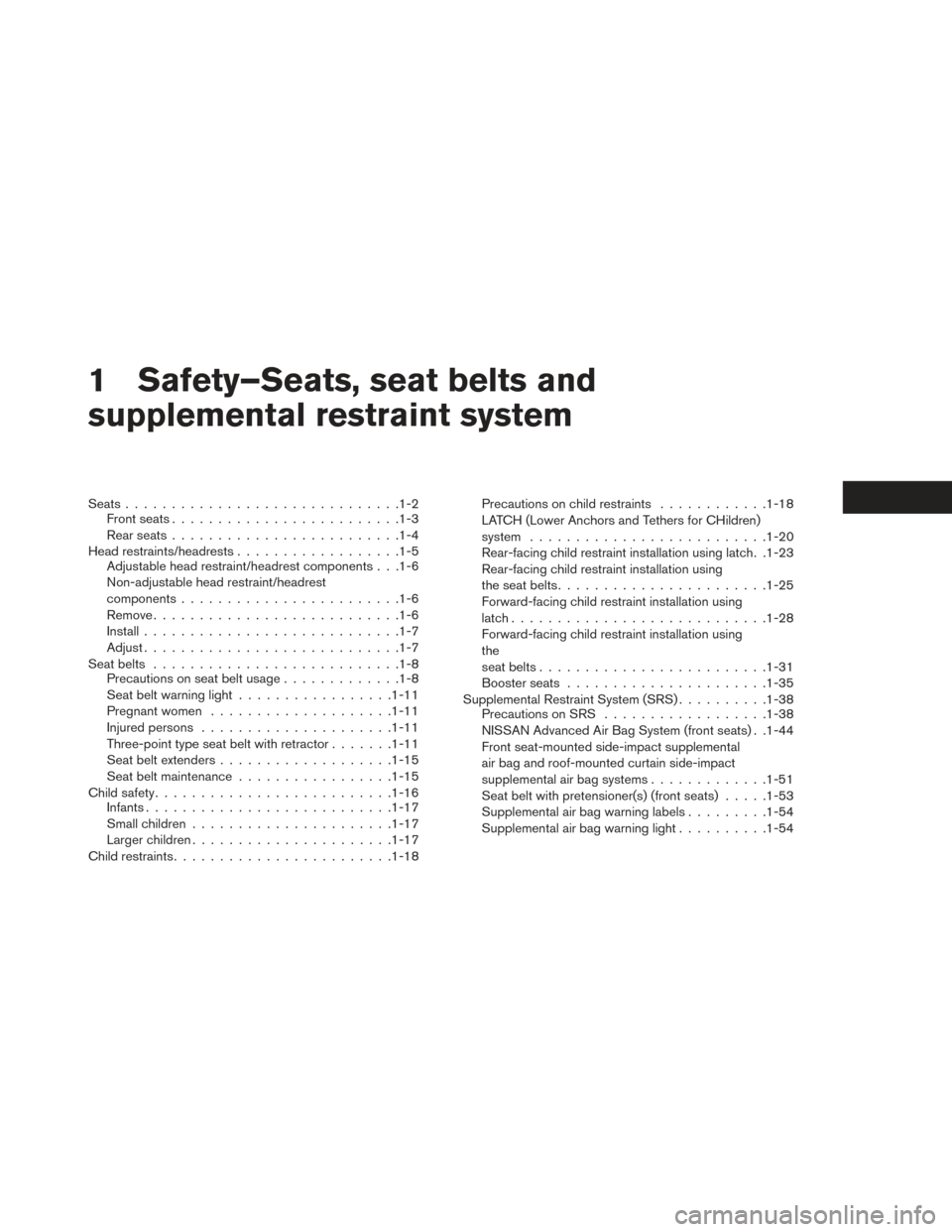
1 Safety–Seats, seat belts and
supplemental restraint system
Seats............................. .1-2
Front seats ........................ .1-3
Rear seats ........................ .1-4
Head restraints/headrests ................. .1-5
Adjustable head restraint/headrest components . . .1-6
Non-adjustable head restraint/headrest
components ....................... .1-6
Remove .......................... .1-6
Install ........................... .1-7
Adjust ........................... .1-7
Seat belts .......................... .1-8
Precautions on seat belt usage .............1-8
Seat belt warning light ................ .1-11
Pregnant women ................... .1-11
Injured persons .................... .1-11
Three-point type seat belt with retractor .......1-11
Seat belt extenders .................. .1-15
Seat belt maintenance ................ .1-15
Child safety ......................... .1-16
Infants .......................... .1-17
Small children ..................... .1-17
Larger children ..................... .1-17
Child restraints ....................... .1-18Precautions on child restraints
............1-18
LATCH (Lower Anchors and Tethers for CHildren)
system ......................... .1-20
Rear-facing child restraint installation using latch. .1-23
Rear-facing child restraint installation using
the seat belts ...................... .1-25
Forward-facing child restraint installation using
latch ........................... .1-28
Forward-facing child restraint installation using
the
seat belts ........................ .1-31
Booster seats ..................... .1-35
Supplemental Restraint System (SRS) ..........1-38
Precautions on SRS ................. .1-38
NISSAN Advanced Air Bag System (front seats) . .1-44
Front seat-mounted side-impact supplemental
air bag and roof-mounted curtain side-impact
supplemental air bag systems .............1-51
Seat belt with pretensioner(s) (front seats) .....1-53
Supplemental air bag warning labels .........1-54
Supplemental air bag warning light ..........1-54
Page 85 of 437
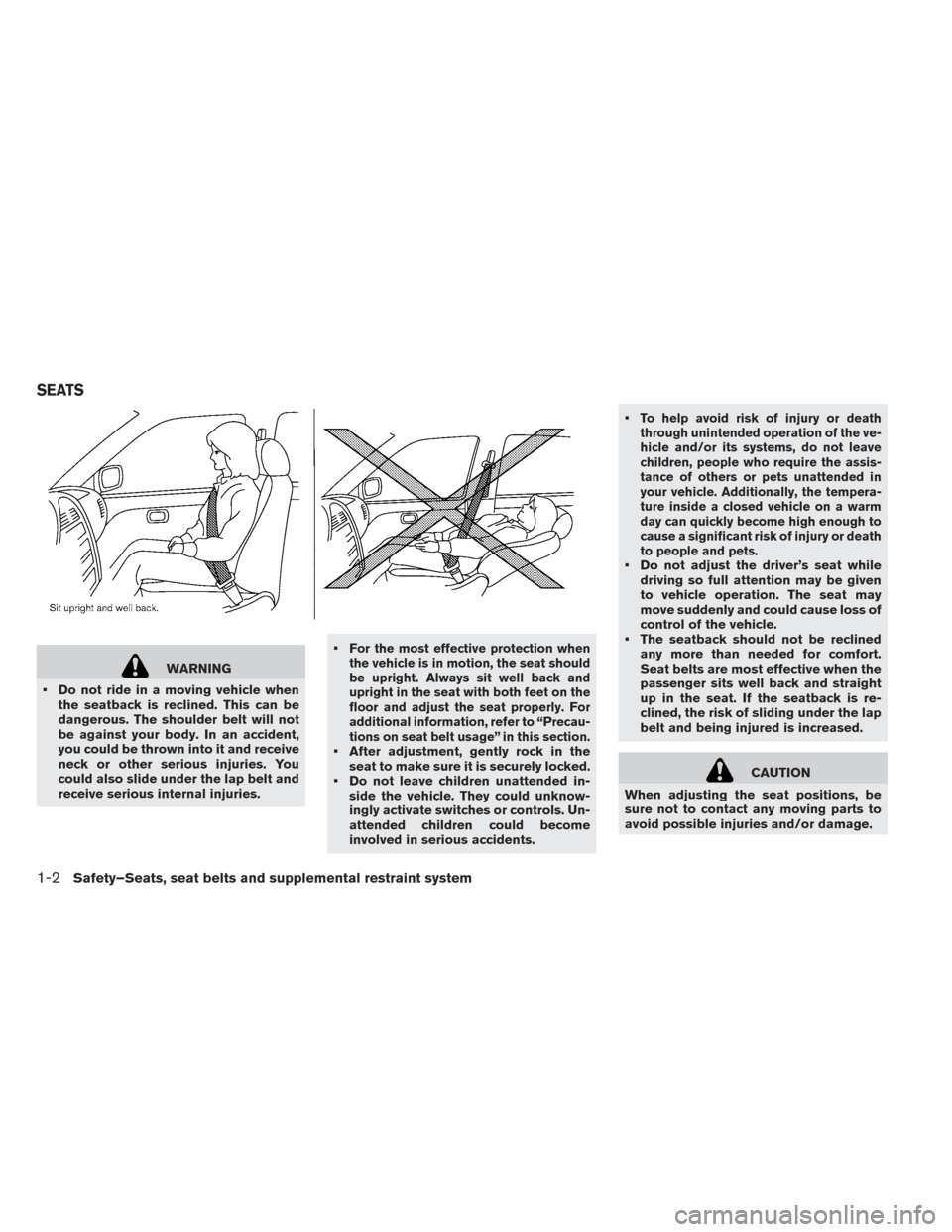
WARNING
• Do not ride in a moving vehicle when the seatback is reclined. This can be
dangerous. The shoulder belt will not
be against your body. In an accident,
you could be thrown into it and receive
neck or other serious injuries. You
could also slide under the lap belt and
receive serious internal injuries. •
For the most effective protection when
the vehicle is in motion, the seat should
be upright. Always sit well back and
upright in the seat with both feet on the
floor and adjust the seat properly. For
additional information, refer to “Precau-
tions on seat belt usage” in this section.
• After adjustment, gently rock in the
seat to make sure it is securely locked.
• Do not leave children unattended in- side the vehicle. They could unknow-
ingly activate switches or controls. Un-
attended children could become
involved in serious accidents. •
To help avoid risk of injury or death
through unintended operation of the ve-
hicle and/or its systems, do not leave
children, people who require the assis-
tance of others or pets unattended in
your vehicle. Additionally, the tempera-
ture inside a closed vehicle on a warm
day can quickly become high enough to
cause a significant risk of injury or death
to people and pets.
• Do not adjust the driver’s seat while
driving so full attention may be given
to vehicle operation. The seat may
move suddenly and could cause loss of
control of the vehicle.
• The seatback should not be reclined any more than needed for comfort.
Seat belts are most effective when the
passenger sits well back and straight
up in the seat. If the seatback is re-
clined, the risk of sliding under the lap
belt and being injured is increased.
CAUTION
When adjusting the seat positions, be
sure not to contact any moving parts to
avoid possible injuries and/or damage.
SEATS
1-2Safety–Seats, seat belts and supplemental restraint system
Page 93 of 437
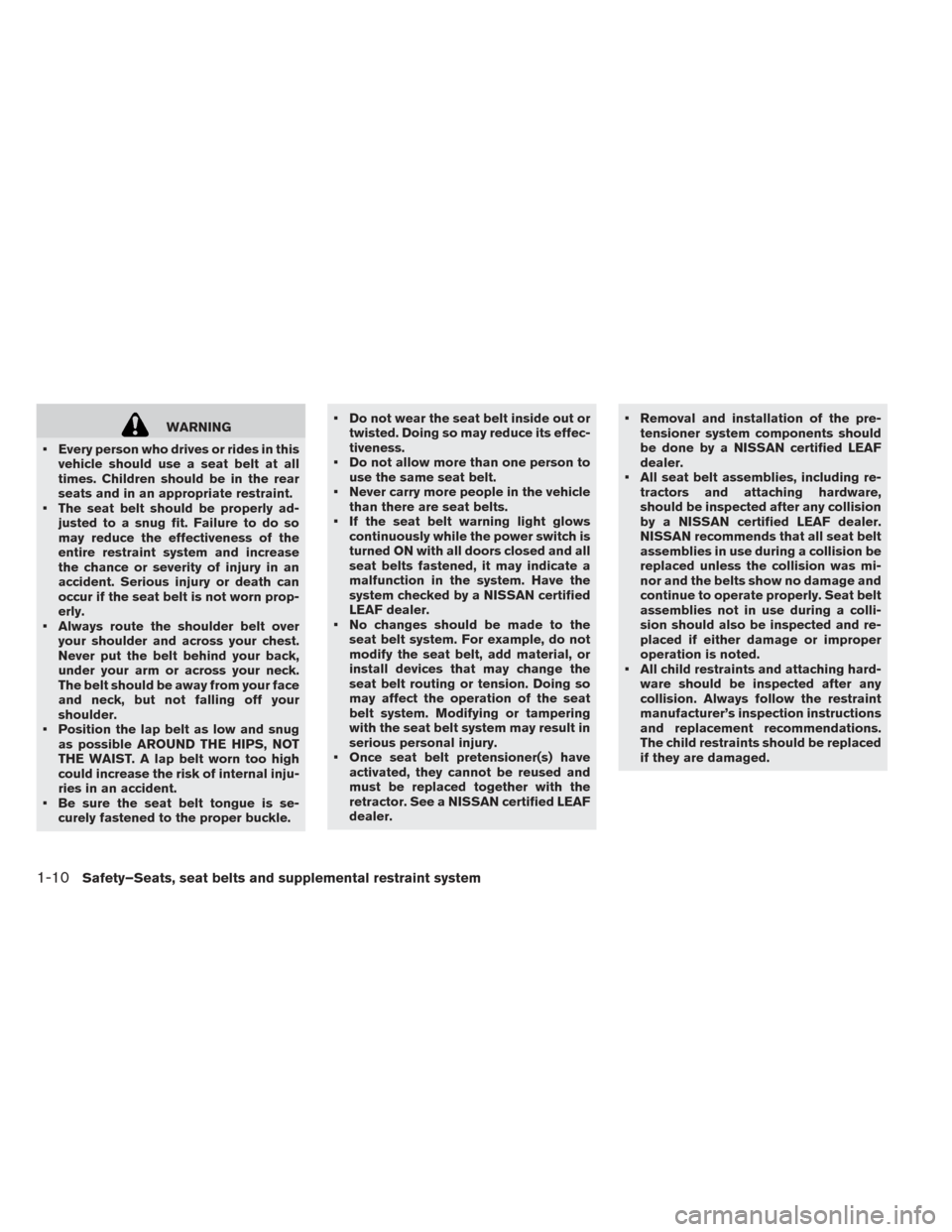
WARNING
• Every person who drives or rides in this vehicle should use a seat belt at all
times. Children should be in the rear
seats and in an appropriate restraint.
• The seat belt should be properly ad- justed to a snug fit. Failure to do so
may reduce the effectiveness of the
entire restraint system and increase
the chance or severity of injury in an
accident. Serious injury or death can
occur if the seat belt is not worn prop-
erly.
• Always route the shoulder belt over your shoulder and across your chest.
Never put the belt behind your back,
under your arm or across your neck.
The belt should be away from your face
and neck, but not falling off your
shoulder.
• Position the lap belt as low and snug as possible AROUND THE HIPS, NOT
THE WAIST. A lap belt worn too high
could increase the risk of internal inju-
ries in an accident.
• Be sure the seat belt tongue is se- curely fastened to the proper buckle. • Do not wear the seat belt inside out or
twisted. Doing so may reduce its effec-
tiveness.
• Do not allow more than one person to use the same seat belt.
• Never carry more people in the vehicle than there are seat belts.
• If the seat belt warning light glows continuously while the power switch is
turned ON with all doors closed and all
seat belts fastened, it may indicate a
malfunction in the system. Have the
system checked by a NISSAN certified
LEAF dealer.
• No changes should be made to the seat belt system. For example, do not
modify the seat belt, add material, or
install devices that may change the
seat belt routing or tension. Doing so
may affect the operation of the seat
belt system. Modifying or tampering
with the seat belt system may result in
serious personal injury.
• Once seat belt pretensioner(s) have activated, they cannot be reused and
must be replaced together with the
retractor. See a NISSAN certified LEAF
dealer. • Removal and installation of the pre-
tensioner system components should
be done by a NISSAN certified LEAF
dealer.
• All seat belt assemblies, including re- tractors and attaching hardware,
should be inspected after any collision
by a NISSAN certified LEAF dealer.
NISSAN recommends that all seat belt
assemblies in use during a collision be
replaced unless the collision was mi-
nor and the belts show no damage and
continue to operate properly. Seat belt
assemblies not in use during a colli-
sion should also be inspected and re-
placed if either damage or improper
operation is noted.
• All child restraints and attaching hard- ware should be inspected after any
collision. Always follow the restraint
manufacturer’s inspection instructions
and replacement recommendations.
The child restraints should be replaced
if they are damaged.
1-10Safety–Seats, seat belts and supplemental restraint system
Page 94 of 437
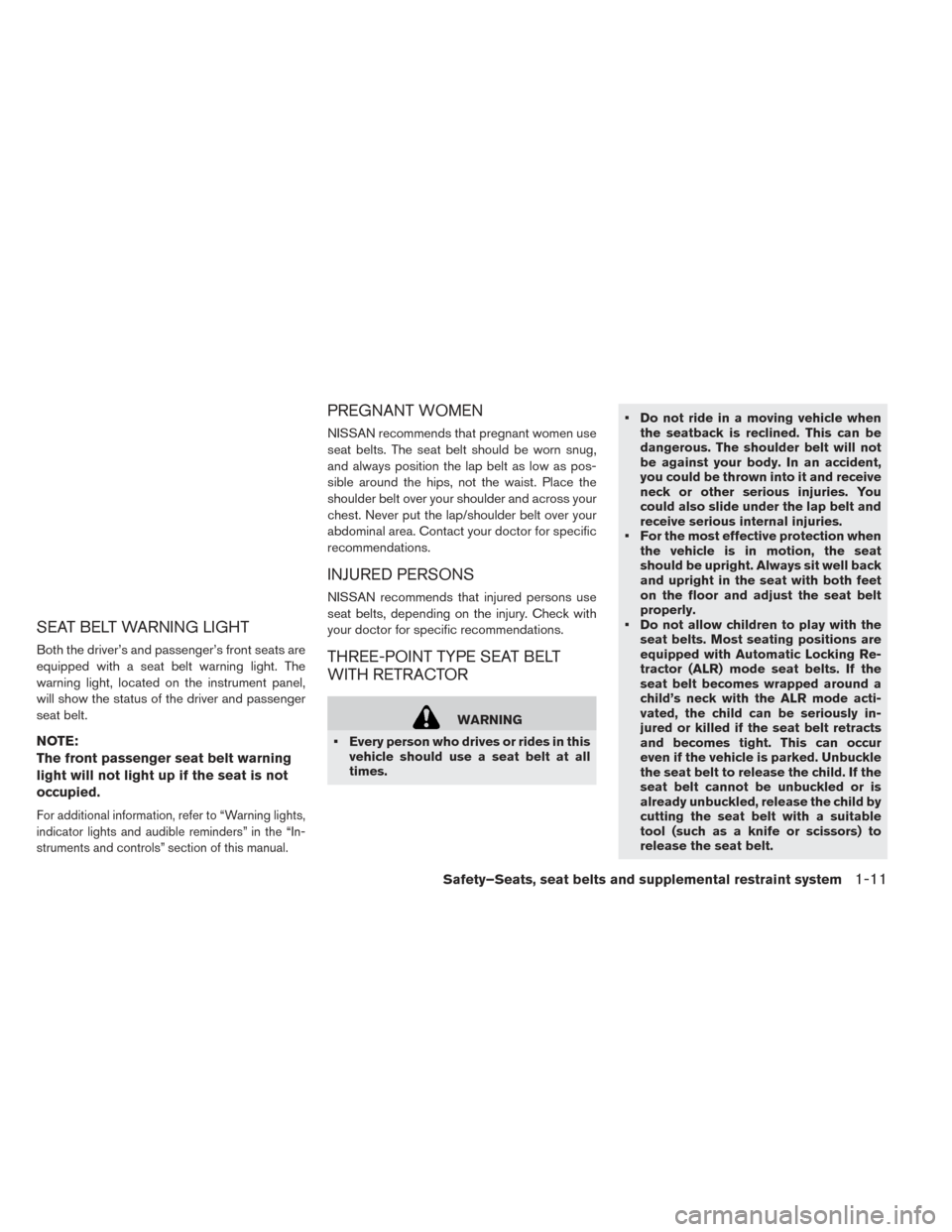
SEAT BELT WARNING LIGHT
Both the driver’s and passenger’s front seats are
equipped with a seat belt warning light. The
warning light, located on the instrument panel,
will show the status of the driver and passenger
seat belt.
NOTE:
The front passenger seat belt warning
light will not light up if the seat is not
occupied.
For additional information, refer to “Warning lights,
indicator lights and audible reminders” in the “In-
struments and controls” section of this manual.
PREGNANT WOMEN
NISSAN recommends that pregnant women use
seat belts. The seat belt should be worn snug,
and always position the lap belt as low as pos-
sible around the hips, not the waist. Place the
shoulder belt over your shoulder and across your
chest. Never put the lap/shoulder belt over your
abdominal area. Contact your doctor for specific
recommendations.
INJURED PERSONS
NISSAN recommends that injured persons use
seat belts, depending on the injury. Check with
your doctor for specific recommendations.
THREE-POINT TYPE SEAT BELT
WITH RETRACTOR
WARNING
• Every person who drives or rides in this vehicle should use a seat belt at all
times. • Do not ride in a moving vehicle when
the seatback is reclined. This can be
dangerous. The shoulder belt will not
be against your body. In an accident,
you could be thrown into it and receive
neck or other serious injuries. You
could also slide under the lap belt and
receive serious internal injuries.
• For the most effective protection when the vehicle is in motion, the seat
should be upright. Always sit well back
and upright in the seat with both feet
on the floor and adjust the seat belt
properly.
• Do not allow children to play with the seat belts. Most seating positions are
equipped with Automatic Locking Re-
tractor (ALR) mode seat belts. If the
seat belt becomes wrapped around a
child’s neck with the ALR mode acti-
vated, the child can be seriously in-
jured or killed if the seat belt retracts
and becomes tight. This can occur
even if the vehicle is parked. Unbuckle
the seat belt to release the child. If the
seat belt cannot be unbuckled or is
already unbuckled, release the child by
cutting the seat belt with a suitable
tool (such as a knife or scissors) to
release the seat belt.
Safety–Seats, seat belts and supplemental restraint system1-11
Page 95 of 437
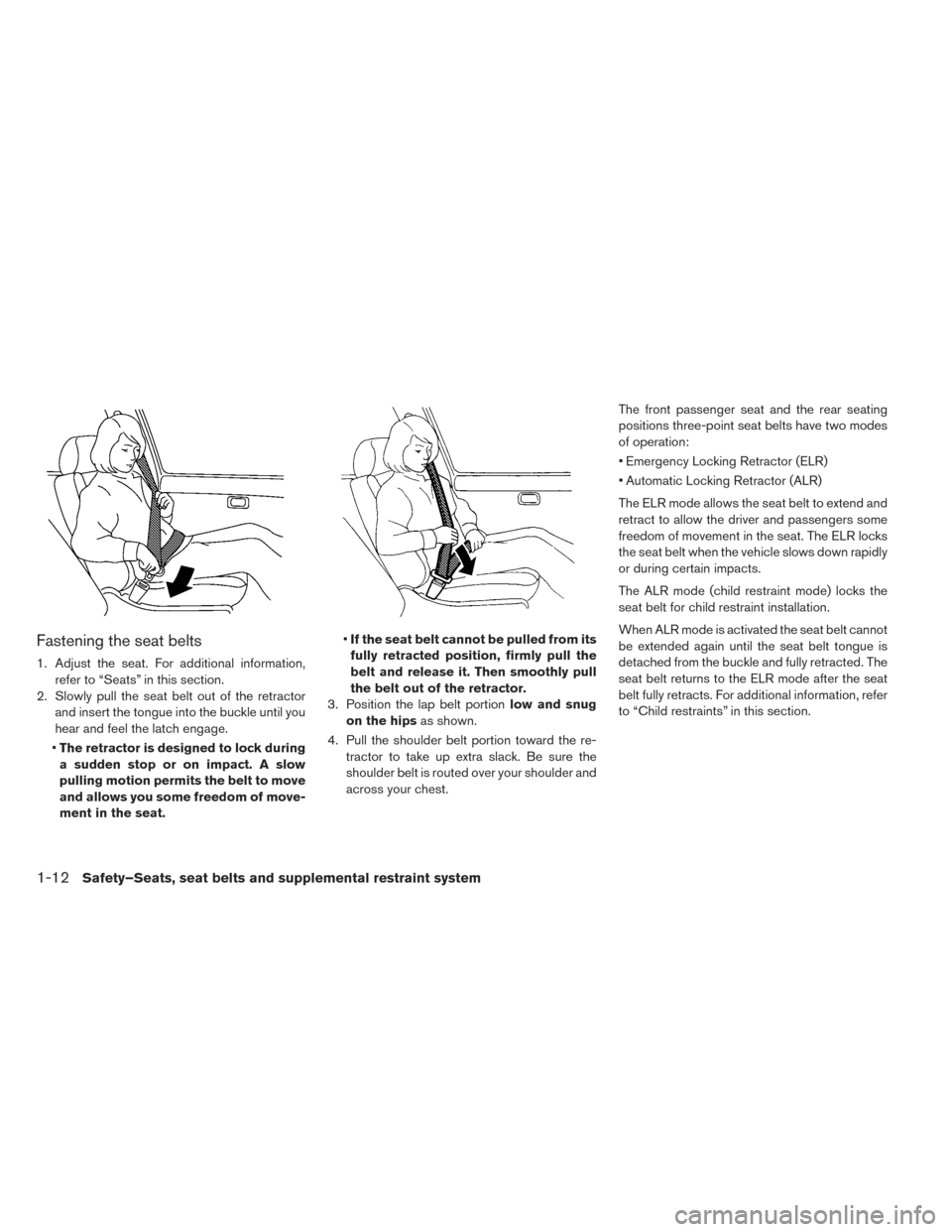
Fastening the seat belts
1. Adjust the seat. For additional information,refer to “Seats” in this section.
2. Slowly pull the seat belt out of the retractor and insert the tongue into the buckle until you
hear and feel the latch engage.
• The retractor is designed to lock during
a sudden stop or on impact. A slow
pulling motion permits the belt to move
and allows you some freedom of move-
ment in the seat. •
If the seat belt cannot be pulled from its
fully retracted position, firmly pull the
belt and release it. Then smoothly pull
the belt out of the retractor.
3. Position the lap belt portion low and snug
on the hips as shown.
4. Pull the shoulder belt portion toward the re- tractor to take up extra slack. Be sure the
shoulder belt is routed over your shoulder and
across your chest. The front passenger seat and the rear seating
positions three-point seat belts have two modes
of operation:
• Emergency Locking Retractor (ELR)
• Automatic Locking Retractor (ALR)
The ELR mode allows the seat belt to extend and
retract to allow the driver and passengers some
freedom of movement in the seat. The ELR locks
the seat belt when the vehicle slows down rapidly
or during certain impacts.
The ALR mode (child restraint mode) locks the
seat belt for child restraint installation.
When ALR mode is activated the seat belt cannot
be extended again until the seat belt tongue is
detached from the buckle and fully retracted. The
seat belt returns to the ELR mode after the seat
belt fully retracts. For additional information, refer
to “Child restraints” in this section.
1-12Safety–Seats, seat belts and supplemental restraint system
Page 96 of 437
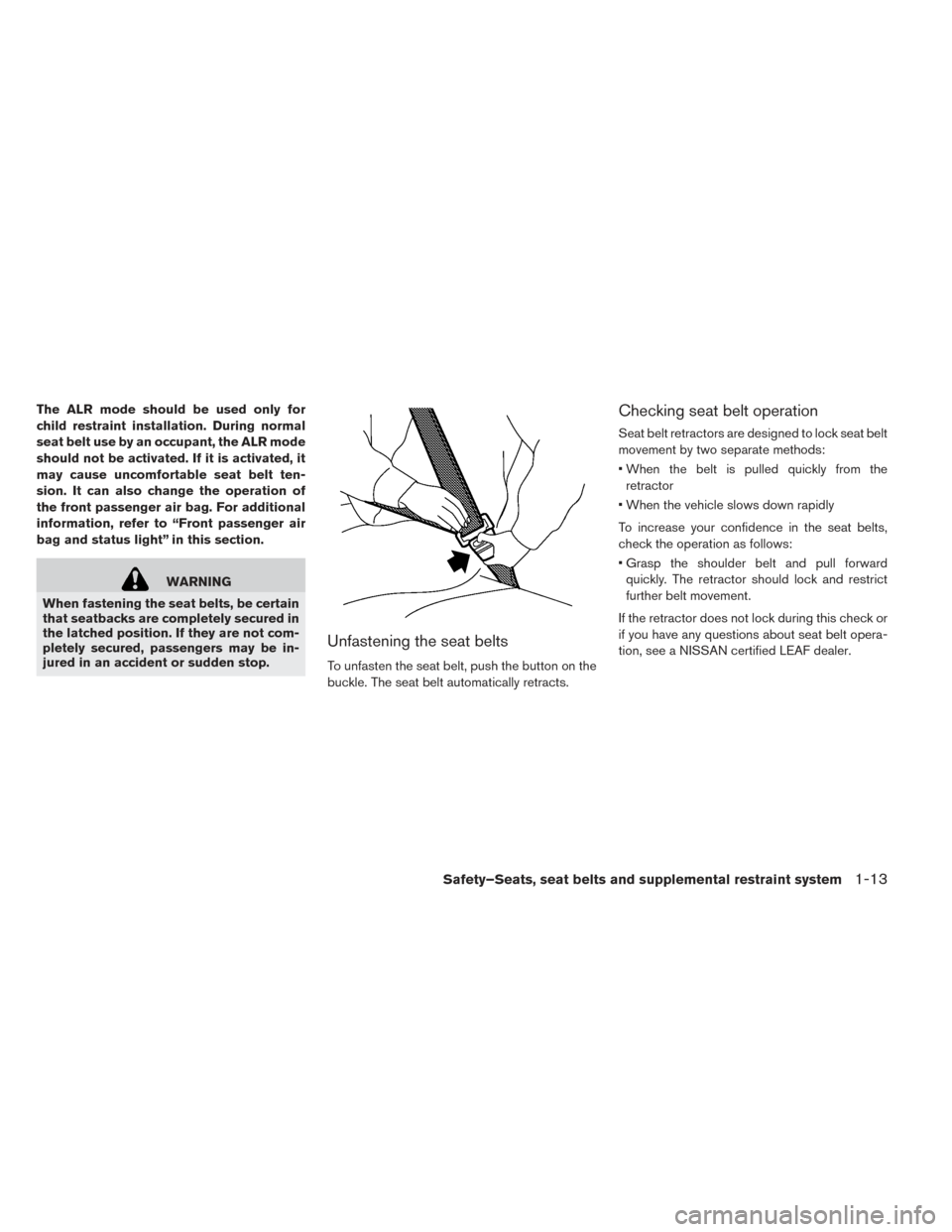
The ALR mode should be used only for
child restraint installation. During normal
seat belt use by an occupant, the ALR mode
should not be activated. If it is activated, it
may cause uncomfortable seat belt ten-
sion. It can also change the operation of
the front passenger air bag. For additional
information, refer to “Front passenger air
bag and status light” in this section.
WARNING
When fastening the seat belts, be certain
that seatbacks are completely secured in
the latched position. If they are not com-
pletely secured, passengers may be in-
jured in an accident or sudden stop.
Unfastening the seat belts
To unfasten the seat belt, push the button on the
buckle. The seat belt automatically retracts.
Checking seat belt operation
Seat belt retractors are designed to lock seat belt
movement by two separate methods:
• When the belt is pulled quickly from the retractor
• When the vehicle slows down rapidly
To increase your confidence in the seat belts,
check the operation as follows:
• Grasp the shoulder belt and pull forward quickly. The retractor should lock and restrict
further belt movement.
If the retractor does not lock during this check or
if you have any questions about seat belt opera-
tion, see a NISSAN certified LEAF dealer.
Safety–Seats, seat belts and supplemental restraint system1-13